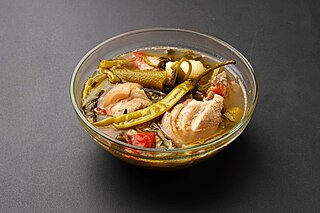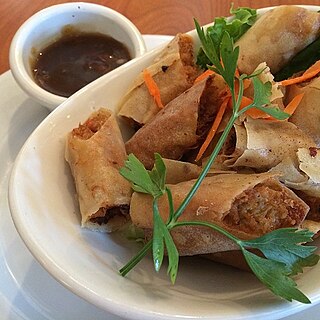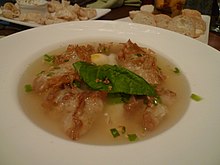
Filipino cuisine is composed of the cuisines of more than a hundred distinct ethnolinguistic groups found throughout the Philippine archipelago. A majority of mainstream Filipino dishes that comprise Filipino cuisine are from the food traditions of various ethnolinguistic groups and tribes of the archipelago, including the Ilocano, Pangasinan, Kapampangan, Tagalog, Bicolano, Visayan, Chavacano, and Maranao ethnolinguistic groups. The dishes associated with these groups evolved over the centuries from a largely indigenous base shared with maritime Southeast Asia with varied influences from Chinese, Spanish, and American cuisines, in line with the major waves of influence that had enriched the cultures of the archipelago, and adapted using indigenous ingredients to meet local preferences.

Sinigang is a Filipino soup or stew characterized by its sour and savory taste. It is most often associated with tamarind, although it can use other sour fruits and leaves as the souring agent such as unripe mangoes or rice vinegar. It is one of the more popular dishes in Filipino cuisine. This soup, like most Filipino dishes, is usually accompanied by rice.

Pancit, also spelled pansít, is a general term referring to various traditional noodle dishes in Filipino cuisine. There are numerous types of pancit, often named based on the noodles used, method of cooking, place of origin or the ingredients. Most pancit dishes are characteristically served with calamansi, which adds a citrusy flavor profile.

Odong, also called pancit odong, is a Visayan noodle soup made with odong noodles, canned smoked sardines (tinapa) in tomato sauce, bottle gourd, loofah, chayote, ginger, garlic, red onions, and various other vegetables. It is garnished and spiced with black pepper, scallions, toasted garlic, calamansi, or labuyo chilis. The dish is usually prepared as a soup, but it can also be cooked with minimal water, in which case, it is known as odong guisado.

Noodle soup refers to a variety of soups with noodles and other ingredients served in a light broth. Noodle soup is a common dish across East Asia, Southeast Asia and the Himalayan states of South Asia. Various types of noodles are used, such as rice noodles, wheat noodles and egg noodles.

Rice vermicelli is a thin form of noodle. It is sometimes referred to as "rice noodles" or "rice sticks", but should not be confused with cellophane noodles, a different Asian type of vermicelli made from mung bean starch or rice starch rather than rice grains themselves.

Filipino Chinese cuisine is a style of Filipino cuisine influenced by Chinese cuisine historically brought to the Philippines by Chinese Filipinos, starting with the Sangley Chinese and their Chinese mestizo descendants and modern descendants in the Chinese Filipino community of the Philippines. It is characterized as a fusion of Fujian/Hokkien cuisine and Cantonese cuisine adapted over the centuries to Filipino cuisine to suit the general Filipino palate/taste.

Bakmi or bami is a type of wheat-based noodles derived from Chinese cooking tradition. It was brought to Indonesia by Chinese immigrants from Southern Chinese provinces like Fujian. It is typically prepared seasoned in soy sauce and topped with pork products, which is often substituted for other protein sources in predominantly Muslim Indonesia. Chinese-style wheat noodles has become one of the most common noodle dishes, especially in Southeast Asian countries which have significant Chinese populations and known by various names.

Batchoy, alternatively spelled batsoy, is a Filipino noodle soup of pork offal, crushed pork cracklings, chicken stock, beef loin, and round noodles. The original and most popular variant, La Paz batchoy, traces its roots to the Iloilo City district of La Paz, in the Philippines.

Molo is a district in Iloilo City, Philippines, located in the province of Iloilo, on the island of Panay in the Western Visayas region. It is the most densely populated district in the city. According to the 2020 census, Molo has a population of 76,393 people, making it the second-most populous district, after Jaro.

Mami is a popular Filipino noodle soup made with wheat flour noodles, broth and the addition of meat or wonton dumplings. It is related to the pancit class of noodle dishes, and the noodles themselves are sometimes called pancit mami.

La Paz is a district in Iloilo City, Philippines, located in Iloilo province, on the island of Panay in the Western Visayas region. It is the third-largest district by geographical area, after Jaro and Mandurriao. According to the 2020 census, it has a population of 54,720 people.

A wonton is a type of Chinese dumpling commonly found across regional styles of Chinese cuisine. It is also spelled wantan or wuntun in transliteration from Cantonese 雲吞 / 云吞 and wenden from Shanghainese 餛飩 / 馄饨. Even though there are many different styles of wonton served throughout China, Cantonese wontons are the most popular in the West due to the predominance of Cantonese restaurants overseas.

Wonton noodles is a noodle dish of Cantonese origin. Wonton noodles were given their name, húntún, in the Tang Dynasty. The dish is popular in Southern China, Hong Kong, Indonesia, Malaysia, Singapore, Vietnam and Thailand. The dish usually consists of egg noodles served in a hot broth, garnished with leafy vegetables and wonton dumplings. The types of leafy vegetables used are usually gai-lan, also known as Chinese broccoli or Chinese kale. Another type of dumpling known as shui jiao (水餃) is sometimes served in place of wonton. Shrimp wonton are mostly known as Hong Kong dumplings. The wontons contain prawns, chicken or pork, and spring onions, with some chefs adding mushroom and black fungus. In Indonesia especially in North Sumatra, West Kalimantan and South Sulawesi, wonton noodles are called mie pangsit.

Pancit choca is a Filipino black seafood noodle dish made with squid ink and bihon. It originates from Cavite, Philippines, and is originally known as pancit choca en su tinta in Caviteño Chavacano. It is also known more commonly as pancit pusit in Filipino. It is a type of pancit.

Lumpiang Shanghai is a Filipino deep-fried appetizer consisting of a mixture of giniling with vegetables like carrots, chopped scallions or red onions and garlic, wrapped in a thin egg crêpe. Lumpiang Shanghai is regarded as the most basic type of lumpia in Filipino cuisine, and it is usually smaller and thinner than other lumpia variants.

Maki mi, also known as pork maki or maki soup, is a Filipino thick pork tenderloin soup originating from the Chinese-Filipino community of Binondo, Manila. It is made from lean pork tenderized by a meat mallet. It is marinated in soy sauce, garlic, black pepper, rice wine or vinegar, and onions before being covered with egg whites or starch. It is then cooked in boiling beef stock, with beaten eggs dropped and stirred until they form strands. Egg noodles (mami) are also commonly added. The name "maki mi" takes its name from Hokkien Chinese, meaning meat soup noodles.

Batchoy Tagalog, also known simply as batsoy, is a traditional Filipino food originating in Luzon. This soup is made with pork, pork offal, pork blood, noodles, chili leaves or garlic chives, green chilies, garlic, onions, and ginger. It also has alternative names such as sutsa or syutsa in the province of Quezon and sinuam in Angono, Rizal. This dish is usually paired with or eaten with cooked rice as a viand.

Iloilo City is a conglomeration of former cities and towns in the Philippines, which are now the geographical or administrative districts (boroughs) composed of seven: Arevalo, City Proper, Jaro, La Paz, Lapuz, Mandurriao, and Molo. All administrative districts are divisions of the lone congressional district of Iloilo City, and each is composed of barangays (barrios), with a total of 180 city barangays.




















